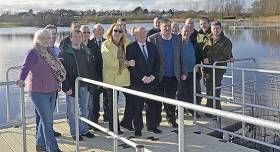Displaying items by tag: Claremorris
Upgraded McMahon Park Fishing Amenity Opens in Claremorris, County Mayo
The upgraded McMahon Park angling amenity at Clare Lake in Claremorris, Co Mayo was officially opened by Minister of State for Tourism and Sport, Michael Ring, TD.
Inland Fisheries Ireland (IFI) significantly upgraded the fishing facilities at the lake, with the installation of new floating fishing stands, wheelchair access, upgraded paths and signage, and the provision of disinfection facilities to clean fishing gear and prevent the spread of invasive species. Fencing was also erected to improve safety around the water and to encourage wild plants and trees to flourish around the lake. The work was completed in conjunction with the local Community Employment Scheme and was funded by the Department of the Environment Amenity Fund.
Speaking at the opening, Minister Ring said: “I am delighted to see this project completed. The angling and walking facilities will have a great impact on local tourism, sport, and recreation. It is a testament to how co-operation between State agencies and local communities can work best, and it is a credit to the town and Mayo. I would like to see Inland Fisheries Ireland develop many more such projects through their National Strategy for Angling Development, which I fully support.”
Dr Ciaran Byrne, CEO of Inland Fisheries Ireland, commented: “Inland Fisheries Ireland has been very pleased to assist the local community in developing this fantastic resource, which can be used as a template for future rural recreation projects around the country. The National Strategy for Angling Development, which was drawn up by IFI, aims to develop the angling resource of Ireland to its maximum potential, and many such projects can be included in the strategy. Dependent on funding, IFI hopes to implement the NSAD over the next few years.”
The work was carried out in consultation with the Clare Lake / McMahon Park Development Committee, representing the local community. The significant improvements to the facilities at Clare Lake have resulted in an increase in anglers using the lake and walkers using the looped walk around the park. The floating pontoons were introduced to provide safer access to the water for young anglers and the looped path to provide a safe and enjoyable walking route for the residents of Claremorris.
Dr Byrne added: “We hope that as a result of this upgrade youth angling in the area will increase and the park will also prove a draw for tourists visiting the area. More than 3,500 people a week are currently using the park for recreation.”





























































